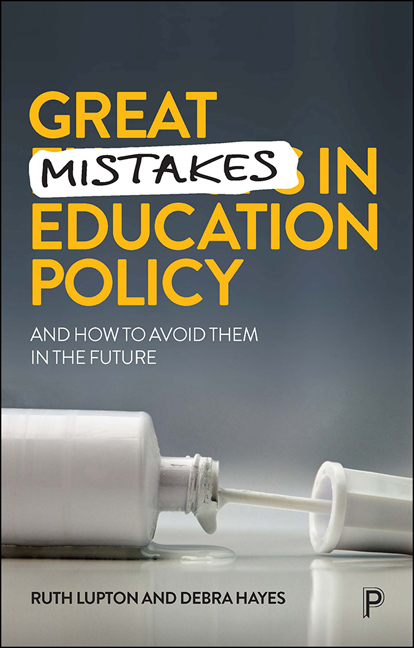Book contents
- Frontmatter
- Contents
- List of tables and boxes
- List of abbreviations
- Notes on the authors
- Acknowledgements
- 1 Introduction
- 2 Setting the scene
- 3 Tests, tests, tests
- 4 Schooling that works for some but not for others
- 5 Teachers making less of a difference
- 6 Mistake #1: turning to the market
- 7 Mistake #2: letting test scores drive policy
- 8 Mistake #3: over-prescribing teachers’ work
- 9 Mistake #4: misunderstanding educational inequalities
- 10 Mistake #5: leaving education out of education policy making
- 11 Synthetic phonics: a ‘perfect storm’ of policy mistakes
- 12 There are alternatives
- References
- Index
2 - Setting the scene
Published online by Cambridge University Press: 23 December 2021
- Frontmatter
- Contents
- List of tables and boxes
- List of abbreviations
- Notes on the authors
- Acknowledgements
- 1 Introduction
- 2 Setting the scene
- 3 Tests, tests, tests
- 4 Schooling that works for some but not for others
- 5 Teachers making less of a difference
- 6 Mistake #1: turning to the market
- 7 Mistake #2: letting test scores drive policy
- 8 Mistake #3: over-prescribing teachers’ work
- 9 Mistake #4: misunderstanding educational inequalities
- 10 Mistake #5: leaving education out of education policy making
- 11 Synthetic phonics: a ‘perfect storm’ of policy mistakes
- 12 There are alternatives
- References
- Index
Summary
School systems in England and Australia
Many people reading this book will know a lot about education in England or in Australia, but perhaps not about both. This chapter sets the scene.
In an era of international ‘policy borrowing’ and ‘policy convergence’ (Ball, 1999, 2019; Sahlberg, 2015), there are many similarities between their education policies. We argue that politicians in both countries have made the same wrong turns and are dealing with some of the same consequences. Yet there are important differences in the structures and organisation of the systems themselves. These enable, or constrain, particular policy choices, creating so-called ‘path dependencies’ in the policy process, and they mean that policies play out in different ways. So, we start by setting out some of the essential characteristics of these education policy landscapes.
A fundamental issue is who makes decisions about schooling. England has a highly centralised system. Central government, in the form of the Department for Education (DfE), sets teachers’ pay scales and professional standards. Systems of assessment and qualification are national, as is the curriculum, and school inspection, although these functions are managed by semiindependent organisations (see Table 2.1). Until relatively recently, there was also a strong role for local education authorities (LEAs). This has been much reduced by the creation of autonomous schools that all report to the DfE. The funding system is now also based on a single national formula. So, the system is simultaneously becoming more centralised and more subject to hyper-local variation as schools can make more of their own decisions.
The Commonwealth of Australia is a federal system of government. The central – or national – government has no specific constitutional responsibility for school education. The six state and two territory governments have historically had responsibility for administration of government schools; development and delivery of curricula; and the regulatory conditions to ensure quality standards across all schools (including non-government schools). However, the constitution allows the national government to provide specific-purpose payments that enable central influence over areas that the states administer. In recent times, these powers have been activated in ways that have greatly extended the influence of the national government over education.
- Type
- Chapter
- Information
- Great Mistakes in Education PolicyAnd How to Avoid Them in the Future, pp. 13 - 26Publisher: Bristol University PressPrint publication year: 2021

